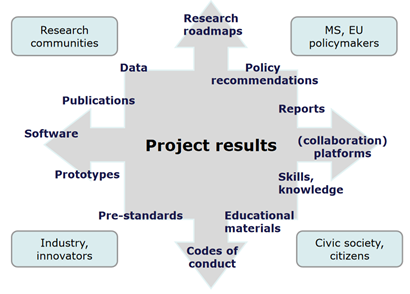Target audiences
 |
Defining target audience(s) and key message(s). |
Research communication and dissemination play a major role to enable inclusion and participation of all these stakeholders. For results generated in European projects the European Commission distinguishes four main stakeholders and target groups:
- Research communities
- Policy makers (on Member State and EU level)
- Industry and other innovators (e.g. SMEs, Start-ups)
- Citizens and Civil Society Organisations
In these guidelines, we particularly focus on reaching industry/innovation (businesses) and civic society/citizen (general public) target groups. However, these target groups are very broad, and for a targeted communication and dissemination it is necessary to specify those target groups further (e.g. large companies, SMEs, startups, business sector/company associations, creative industry, NGOs, CSOs, citizens, elderly people, maker community, etc.).
It is important to disseminate specifically to target groups. A crucial element is to get to know your target audience. If possible, it is recommendable to meet representatives from the target groups in person (e.g. contacts from a company that you are already in contact or negotiating with) and to directly ask them about their needs and expectations of the research outcomes. Then you can tailor your dissemination/communication material and strategy accordingly.
Another advice if you are dealing with a very specific and small target group (e.g. policy makers): Invite them to discuss the expected outcomes before writing the final document that they will receive. Having a dialogue in advance is as important as the final document itself.
Once you know your target group, it is essential to define the key message that you want to communicate. In general, it is important to make sure that the key messages and information that you provide is relevant for the targeted audience. A good recommendation is to explicitly include the audience in the material that you produce (e.g. a dossier, brochure). Write about your audience to make sure that the information contained specifically relates to them and is relevant.
A tip that works for all communication formats: present the information always thinking about your target audience. Try to understand what type of information they will need from you. If they are consumers they do not need to know how it works, just how it is going to benefit their life. Industry might be interested in more details. Always think of what THEY want to hear from you, not what you want to tell them. You do not need to talk to all audiences at the same time.
Also, it is not necessary to communicate about everything. For instance, if your results are not available yet it is not necessary to communicate about them to your audiences yet.





